#boxoffice magazine
Text

Witchcraft '70, ad, Boxoffice magazine, The National Film Weekly, 1970
#witches#documentarians#occult#vintage#witchcraft '70#witchcraft#luigi scattini#angeli bianchi... angeli neri#white angels#black angels#boxoffice magazine#the national film weekly#1970#ad
266 notes
·
View notes
Photo
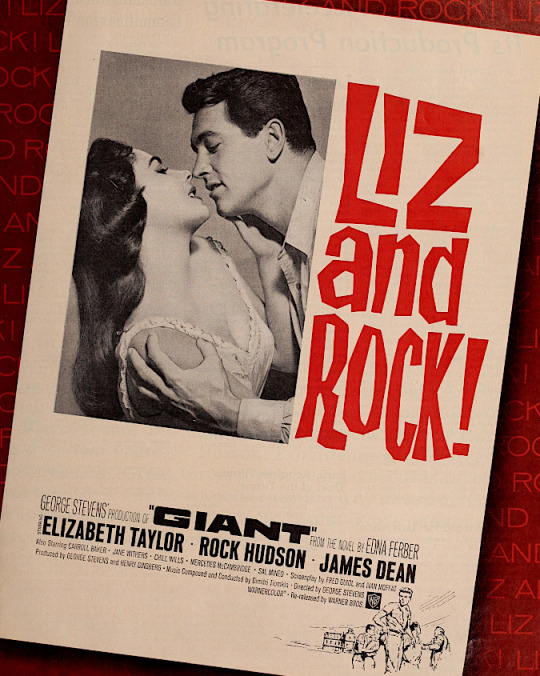
Boxoffice, February 4, 1963
#elizabeth taylor#rock hudson#giant#magazine: boxoffice#year: 1963#decade: 1960s#type: advertisements
48 notes
·
View notes
Text

"How come? What is this Hepburn magic? How can a girl on the spot spend nine weeks in a sensation-jaded place like Hollywood and, by doing nothing spectacular, leave it babbling poems of praise in her wake? How, for instance, could she make a glamour-gorged guy like Bill Holden get lyrical about her “elegance and fascinating formality?” Or a vet like Joan Crawford, who only caught a glimpse of her, call her “the greatest thing to happen to Hollywood in years.” How, for that matter, could fans all over the land boost Audrey to the top boxoffice ten after only one picture? What’s the girl got?
She wears a size eight shoe and she has a small face perched on a long, gazelle-like neck. She holds her back straight and her slightly slanted nose seems always to be pulling everything up. She looks like one of those Pharaoh’s daughters on an ancient papyrus scroll."
-Modern Screen magazine, April 1954
52 notes
·
View notes
Text

WAR OF THE COLASSAL BEAST (1958) cast and crew on the cover of Boxoffice magazine-that's James Nicholson and Samuel Arkoff of AIP with Dean Parker.
8 notes
·
View notes
Text
Never forget how far we've come. (Homophobia quoted below the break.) The world isn't good for us now, but it's better than it was.
Found a review of the 2008 lesbian romance "I Can't Think Straight". Tim Cogshell, still a prominent critic as far as I can tell, wrote for Boxoffice Magazine in 2008. The full review has been lost to capitalism's disregard for archival integrity, but Rotten Tomatoes quotes it as: "This is a tasteful, romantic lesbian flick, and neither romance nor taste is a substitute for hot naked lesbians getting it on."
This was fifteen years ago, when my lesbian aunt worked at a video rental shop to make ends meet because teaching doesn't pay enough. She kept up with movie news, and the review - while aggressive - was probably something she read (she subscribed to the magazine, then) and was hurt by, but likely couldn't share her hurt with anyone outside of perhaps her partner and close friends. Today, though that review would likely still be repeated by bigots, I can at least hope we'd call it out. There would be some kind of accountability. There's a long road ahead of us, but we're not traveling alone anymore.
0 notes
Text
Boxoffice Pro Magazine
Boxoffice Pro is a leading magazine in the movie industry, providing readers with up-to-date news, data, analysis, and insight into the box office and exhibition industry. The magazine is published by Boxoffice Pro LLC, a media company that has been serving the movie industry for more than 100 years. The magazine has become a must-read publication for anyone who is interested in the movie industry, from movie theater owners to filmmakers, distributors, and industry analysts.
Boxoffice Pro magazine provides its readers with exclusive coverage of the latest developments in the movie industry. The magazine’s articles cover a broad range of topics, including box office data, movie theater operations, film distribution, marketing, and technology. The magazine also provides in-depth interviews with industry leaders and analysis of industry trends. Readers can expect to find articles on topics such as the impact of streaming services on movie theaters, the latest advancements in movie theater technology, and the performance of movies at the box office.
0 notes
Photo
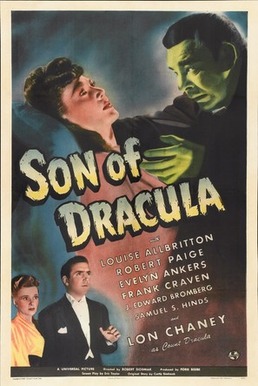
Son Of Dracula (1943)
Son of Dracula is a 1943 American horror film directed by Robert Siodmak with a screenplay based on an original story by his brother Curt Siodmak. The film stars Lon Chaney, Jr., Louise Allbritton, Robert Paige, Evelyn Ankers, and Frank Craven. The film is set in the United States, where Count Alucard (Chaney Jr.) has just taken up residence. Katherine Caldwell (Allbritton), a student of the occult, becomes fascinated by Alucard and eventually marries him. Katherine begins to look and act strangely, leading her former romantic partner Frank Stanley (Paige) to suspect that something has happened to her. He gets help from Dr. Brewster (Craven) and psychologist Laszlo (J. Edward Bromberg) who come to the conclusion that Alucard is a vampire.
The film is the third in Universal's Dracula film series following Dracula's Daughter (1936). The film was made under different circumstances than the previous two entries in the series with a new Chairman of the Board working at Universal and several horror sequels being made since the success of the film Son of Frankenstein (1939). The film was initially being written by Curt Siodmak who was later replaced by Eric Taylor. Filming began on January 7, 1943 and concluded on February 2. Few documents related to the film's production survive from studio files or trade reports.
Son of Dracula was held back from release for about six months before its premiere in the United States, with the earliest known release date being on October 20, 1943, at Cine Olimpia in Mexico City. On its initial release, the trade magazine Boxoffice declared Son of Dracula as a hit in the United States where its sales were 23% above average. Initial reception to the film was described as "varied" by film historian Gary Rhodes.
1 note
·
View note
Photo



Magazine Boxoffice redesign by She Was Only
1 note
·
View note
Photo


One last bit from the "Portfolio of Theatre Planning Ideas” in Boxoffice, 22 October 1962.
Just some nice pics and descriptions of late 1950s/early 1960s auditoriums, hard-top and drive-in both.
#boxoffice#boxoffice magazine#trade press#1962#exhibition history#movie theaters#film exhibition#film history#exhibition#theatrical exhibition#drive-in theater#hard-top theater#modernist design#midcult#mid-cult#media history digital library#mhdl#cinema#movies#film
1 note
·
View note
Photo

Cover of Boxoffice magazine May 1973 featuring the poster art for Booby Trap.
43 notes
·
View notes
Photo

Boxoffice Barometer, 1947
#ingrid bergman#magazine: boxoffice barometer#year: 1947#decade: 1940s#type: studio and publicity photos
98 notes
·
View notes
Video
youtube
Flavos Frank 'n' Beans Combo concession trailer (Flavo-rite/Filmack, 1955)
Snipe from an original 35mm print, scanned in 4K by Film-Tech.
From BoxOffice Magazine:
"Flavos Frank 'n' Bean Combo, consisting of a split, spiced frankfurter baked with molasses flavored beans in a crisp, flaky noodle jacket, is being introduced in the drive-in theatre concessions trade by Flavo-Rite, Inc. Pretested in the New England and New York areas as a high ticket item at 35-40 cents, the combination of frankfurter and baked beans proved a highly profitable concessions product. the 4x5-inch serving is precooked in a deep-fat frier, frozen and packed 48 units to a carton, with glassine dispensing bags included in the package. Under normal conditions, the Combo may be stored fro up to 12 days. It requires only quick deep-fat frying for serving at the theatre concessions. Free promotional material suppled with the combos include counter displays, jingle-type, full-color trailer, as well as the glassine bags printed in red and green.
2 notes
·
View notes
Note
Get ready for a minion laughs in the funniest 3D blockbuster hit of the year! Vying for the title of “World’s Greatest Villain”, Gru (voiced by Steve Carell) – along with his hilarious crew of mischievous minions – plots to pull off the craziest crime of the century: steal the moon! But when Gru enlists the help of three little girls, they see something in him nobody else has ever seen: the perfect dad. From executive producer Chris Meledandri (Horton Hears a Who, Ice Age), and featuring the voices of an all-star comedic cast, including Jason Segel, Russell Brand, Miranda Cosgrove and Julie Andrews, Despicable Me is “rousingly funny, heartfelt and imaginative” (Pete Hammond, Boxoffice Magazine).
augh
1 note
·
View note
Photo
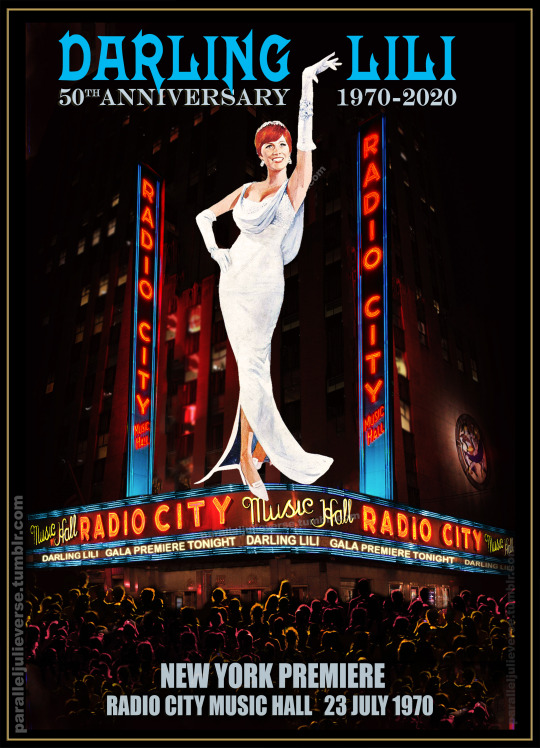

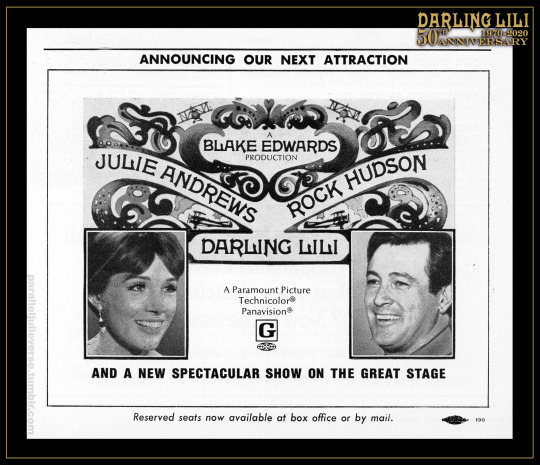

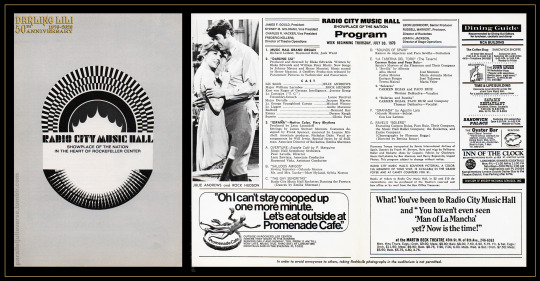
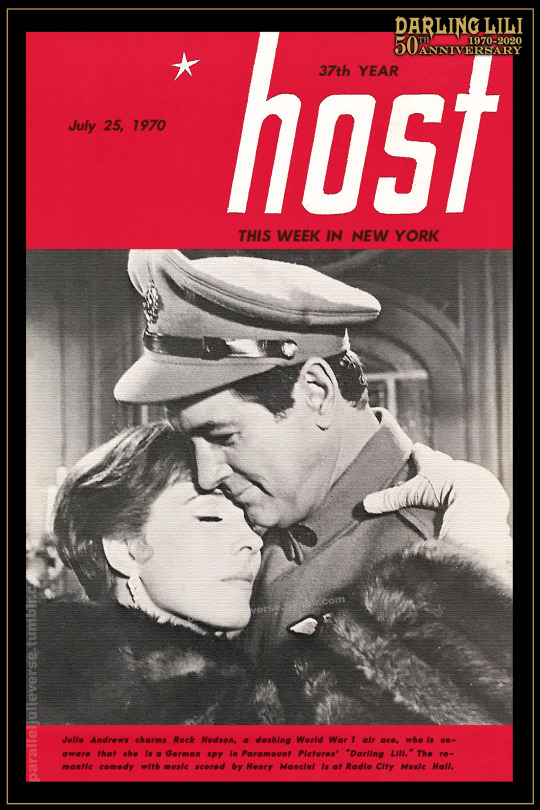
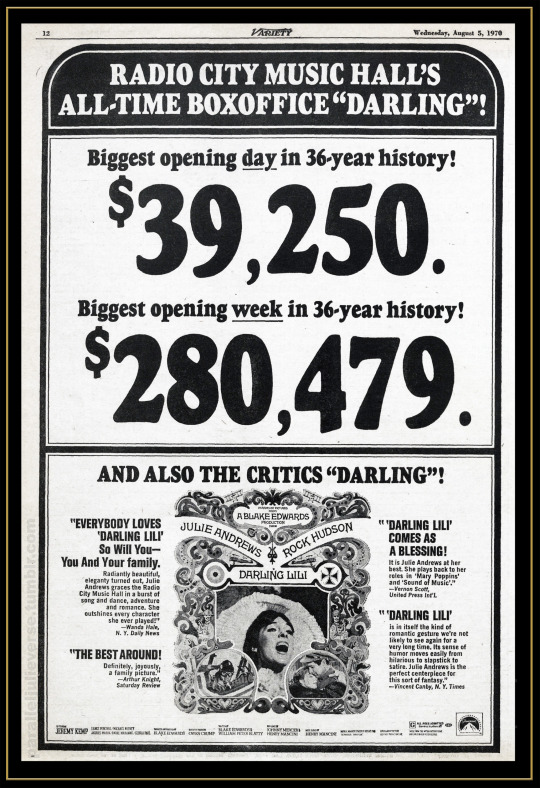
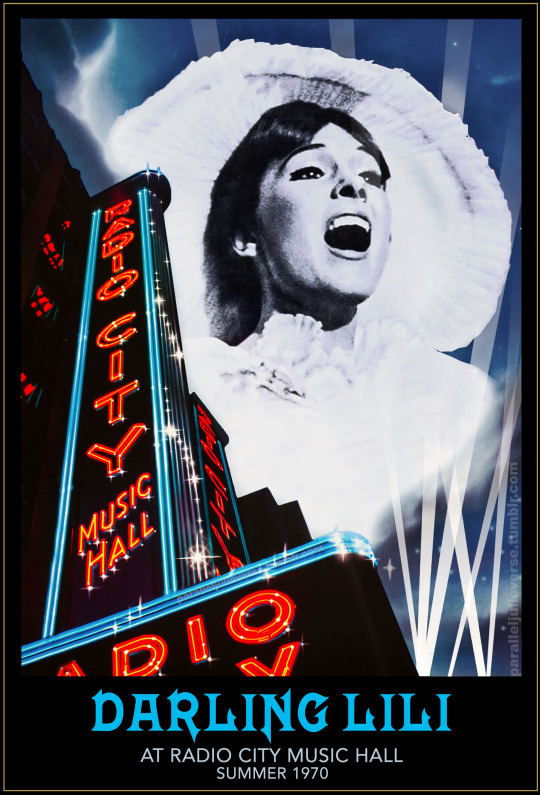
Darling Lili in New York, or Where Were You the Night Julie Andrews Played Radio City Music Hall and Stole Manhattan’s Heart?
This is the second in a series of commemorative posts to mark the 50th anniversary of Darling Lili, the last of the 1960s Julie Andrews screen musicals. In the preceding post, we looked at the film’s fraught production history up to and including its World Premiere at Hollywood’s Cinerama Dome on 23 June 1970. Here, we turn attention to the film’s New York bow which took place a month later on 23 July at the city’s fabled Radio City Music Hall.
Nicknamed “the show place of the nation”, Radio City Music Hall was for much of the mid-twentieth century the venue of choice for big event film releases. The theatre’s monumental size, architectural opulence, state-of-the-art technology, and pre-show stage spectacles made it “the quintessential motion picture palace,” and Hollywood studios jockeyed to secure bookings at “the Hall” for their most prestigious pictures (Goldman, 97-98).
During the late-60s, Paramount, the studio behind Darling Lili, enjoyed a run of extremely successful summer bookings at Radio City Music Hall. Its 1967 release, Barefoot in the Park broke house records for the longest run at the Hall with a 12-week season, only to be bested the following year by another Paramount comedy, The Odd Couple which ran for 14-weeks (”Trouble”, 114). It was something of a PR coup, therefore, when, in January 1970, Paramount announced with much fanfare that Darling Lili would make its official premiere as the summer attraction at Radio City Music Hall later in the year (”Par Gets”, 3). The deal even made the front cover of Boxoffice magazine with a photo of Frank Yablans, Paramount general sales manager, proudly signing the booking contract with Music Hall president, James F. Gould (″Sign of Summer,”, cover).
Barely had the ink dried on the deal, however, when Paramount changed tack. Hit by the toughest industry recession in decades and spooked by a precipitous downturn in the market for big-budget roadshow films, Paramount execs implemented a wholesale revision of studio operations, including a brutal hard-prune of their production and release schedules (Dick, 120ff). By April, earlier plans to give Darling Lili a high profile release had been ditched and, in its stead, Paramount decided to offload the film cheaply as part of a bundle of eight titles slated for saturation release during the summer off-season. Dubbed the “Big Summer Playoff,” the aim was to issue the films widely and quickly so that they could “saturate every major and minor market with single-house firstruns and key city multiples” (“Paramount’s Summer Playoff”, 5). In an era when important films were typically given carefully staggered roll-outs, it was an unorthodox move that fuelled advance perceptions of Darling Lili as a bomb of such magnitude that even its own studio had lost hope. As one newspaper commentator put it, Paramount “seems to have dumped the expensive movie rather than spend any more on it” (Taylor, 21-E).
Radio City Music Hall, by contrast, stuck to its original plans to exhibit Darling Lili as a high-profile summer spectacular. With Paramount having started to issue the film haphazardly to theatres across the nation in June, the opening of Darling Lili at Radio City on July 23 would no longer be a world premiere -- that honour was hastily devolved to Hollywood’s Cinerama Dome -- but the Hall persisted in proudly billing its run as “the New York premiere”. As Variety wryly noted: “Music Hall has never played a pic which hasn’t been a New York first, although perhaps someone there thought the tourists may have thought Lili was otherwise in that the film opened nationally a month ago” (”New York”, 20).
While not strictly a roadshow presentation, Radio City Music Hall exhibited Darling Lili with all the trappings of a hardticket prestige release. Seats were available via a mix of both premium reserved and general admission with special complimentary programs issued to patrons at all sessions. The theatre screened the film in wide-gauge 70mm with 6-track stereophonic sound, one of only two US venues to do so. Projected on the Hall’s 70′x40′ motion picture screen -- the largest indoor screen in the world at the time -- the film would have looked and sounded amazing (Goldman, 99). As an added point of appeal, screenings were supported by one of the Hall‘s famous live stage entertainments: in this case, a Spanish-themed spectacular with symphony orchestra, flamenco dancers, guitarists and, of course, the legendary high-kicking Rockettes (Jose, 54). In addition, the Hall lavished Darling Lili with a solid promotional buildup, taking out full page ads in key newspapers, and using strategically-placed billboards and transit ads around town.
It was an old-school approach of event-style cinema showmanship that paid off handsomely. Even before Darling Lili opened at the Hall, there was “an unprecedented advance demand” for tickets, leading the theatre to double the number of reserved seats from 900 to 1,800 for all sessions. “We’ve added reserve seats on a few occasions previously,” observed a theatre rep, but “only during the heavily crowded Christmas and Easter holiday seasons” and never...during the summer,” adding that he had “no idea” what had generated the extraordinary advance demand (Weiler, 37).
The good news continued when the film opened on July 23 with a box-office rush that broke all house records, prompting the theatre to increase reserve bookings even further to 2500 seats in an effort to accommodate the clamour for tickets (“’Lili’ Hitting Peak,” E-2). As Variety commented:
“Radio City’s Darling Lili...is the summer blockbuster all the auspices hoped it would be, with $285,000 or close expected for kickoff session. Pic is curious in that its longtime postproduction shelving had spurred rumors of disastrous artistic results. But film has shown legs in crosscountry openings and both critical and word-of-mouth opinion in Manhattan has been mixed at worst. Some response is downright enthusiastic” (“’Lili’ and Revue,” 9).
Darling Lili continued its bullish box-office run in New York, long after any initial novelty buzz should have subsided. Weekly grosses inched higher for a few weeks before settling into a very healthy $200K+ per week plateau. Come mid-August, Variety noted with thinly-veiled surprise that:
“Radio City Music Hall is experiencing a slight phenomenon with its current Darling Lili attraction. It’s not unusual during the summer tourist season for popular Hall programs to maintain or build grosses...but few remain in such a narrow range as has Lili to date. First week tally of $280,000 was a non-holiday record. Second was upped to $288,000. Now third session is headed for $280,000....70mm projection and sound are plus-values in a package which Hall president James Gould predicts will run until late September” (“N.Y. Full,” 9).
In the end Darling Lili did run at Radio City Music Hall until late-September -- September 23, to be precise -- when it closed to make way for the pre-booked Sophia Loren-vehicle, Sunflower. Across its 9-week run, the film grossed in excess of $2million in ticket sales, making it one of the theatre’s biggest summer hits to date (“Picture Grosses,” 15).
The commercial success of Darling Lili at the Hall was music to the ears of the film’s star who, in a rare moment of unguarded hubris, admitted to a measure of self-satisfaction at news of the booming box office receipts:
“‘I’m not so interested for myself,’ she explained, ‘but I’m happy for Blake. He has been so maligned about this picture that I am delighted he is receiving some vindication...I think he managed to make a vastly enjoyable film...People are entertained by it; the Music Hall figures seem to prove that.’
[T]he actress had mild reproof for the releasing company, Paramount, over its handling of the film:
‘Three weeks before the opening, there was no advertising campaign. None whatsoever. Paramount didn’t seem to know how it was going to sell the picture--or if. I simply can’t understand an attitude like that’” (Thomas: 13).
Julie’s chiding of Paramount for its poor handling of Darling Lili was not mere sour grapes. Once the studio had decided to issue the film as part of a summer saturation bundle, it effectively abandoned any semblance of cogent or even halfway organised marketing. As outlined in our earlier post, there was little rationale to the film’s distribution. Lili appeared suddenly and briefly at second-run theatres and drive-ins across disparate suburban and provincial areas, while major metropolitan venues didn’t get the film till much later, if at all. In many markets, the film was booked for a fleeting season of a week or two – in some cases, just a few days -- and it was frequently paired as a double-bill with a host of poorly selected partner titles (Caen, 6-B).
The studio’s approach to promotion was no better. A generic pressbook and merchandising manual was issued, but it was very bare-bones and perfunctory. In the absence of a clear marketing plan, local exhibitors were left to promote the film more or less any way they liked. Advertisements were frequently altered to pitch Darling Lili in diverse, and often contradictory, ways. The main advertising art provided by Paramount -- with its central image of Julie in mid-song set within a sepia frame of art nouveau swirls -- positioned the film principally as a nostalgic star musical with touches of adult romance. Many local exhibitors took a very different approach. Some tried to reframe it as wholesome child-friendly fare: “This summer’s one and only total family entertainment;” “It’s Julie at her best! It’s for your family” (“This Summer,” 24). Other theatres pegged it as “a man’s movie,” stressing the action and warfare elements with taglines like “See the Best Dogfights of World War I” or “If you enjoyed Blue Max you’ll love Darling Lili” (“Man’s Movie”, 13; “Palms”, 64). Some exhibitors even openly recycled graphics from The Blue Max and other WW1 action films, with one Florida venue going so far as to revive the film’s original working title: Darling Lili, or Where Were You the Night You Said You Shot Down Baron Von Richtofen? (“Amusements,” 11A).
Elsewhere, exhibitors implemented a rash of dubious promotional incentives such as “twofers” or free entry to "one child under 12...with the purchase of one adult admission to Darling Lili” (“Capri”, 2D). A theatre in Fort Lauderdale offered “free admission to World War I veterans in uniform during matinees Monday through Friday” (“’Darling Lili’ Ducats,” 5D). Possibly well-intentioned gestures but it was bottom-barrel marketing that fostered an unfortunate aura of abject desperation around the film that likely turned off more patrons than it enticed.
Against this sorry backdrop of shambolic distribution and ham-fisted marketing, the meticulous handling of Darling Lili at Radio City Music Hall served as a strikingly singular counterpoint. The remarkable commercial success of the film at that venue -- which, if reported figures are to be believed, represented well over a third of the film’s entire US grosses (“US Films,” 184) -- can only be attributed in good part to the care and professionalism with which the Hall managed the film’s exhibition. One can’t help but wonder, therefore, how different the overall commercial fate of Darling Lili might have been had Paramount exercised a more discriminating distribution plan, affording the film the kind of special-event release it enjoyed in New York. It’s unlikely Lili would ever have been a major hit -- it was simply too narrow in appeal and out-of-step with the rapidly changing times -- but it certainly could have gone much further in recouping costs and might even have realised a modest profit. At a minimum, it would have helped redeem the film from its unjust reputation as the “Edsel that almost bankrupted Paramount Pictures” (Rosenfield, 5).
As a coda to this account of the exceptional history of Darling Lili at the Radio City Music Hall, it is interesting to note that the film fared well in New York not just commercially but also critically, Some of the film’s best US reviews came from New York critics -- a surprising turn-of-events given how notoriously hostile the East Coast critical establishment had been to Julie Andrews’ earlier screen musicals. Wanda Hale of the New York Daily News gave Darling Lili three-and-a-half stars out of four, writing:
“Radiantly beautiful, elegantly turned out, Julie Andrews graces Radio City Music Hall in a burst of song and dance, adventure and romance...[I]t’s Darling Lili everybody loves, so will you, you Music Hall patrons--you and the family” (Hale, 39).
Vincent Canby (1970) of the New York Times found Darling Lili “a pure if not perfect comedy” with “a lot of perverse charm and real cinematic beauty.” He continued:
“Although Julie Andrews (the film, not stage, star) has always struck me as a very mitigated delight, she may be the perfect centerpiece for this sort of fantasy. That is, her angular, aggressive profile, combined with her coolness and precision as a comedienne and a singer, give the immediate, comic lie to the adventures of a supposedly irresistible femme fatale. She thus is immensely funny...” (16).
In a rare honour, the New York Times afforded Darling Lili a second review from Roger Greenspan (1970) who argued for the film as a minor masterpiece of refined, borderline philosophical, sensibilities. “[O]ne very bright critic I know...has already compared the film, ecstatically, with Max Ophul’s great Lola Montes,” he remarked before launching into his own rhapsodic paean:
“To her characterisation, Miss Andrews brings a precision of gesture that matches Edwards’s directorial precision and that constitutes one of the most excitingly controlled expressions of theatrical presence I have ever seen in a movie. Not cold; elegant, finely drawn, perfect of its period--and yet inward, self-sustaining, as if already committed to that gorgeously contemplative state of transport that is the subject of the movie within the movie to look for in Darling Lili” (S2-10).
In a similar move, the inaugural issue of the New York-based cinephile journal, On Film devoted not one but two essay-tributes to Darling Lili from Stuart Byron and Mike Prokosch respectively. The former gushed:
“Darling Lili comes at the end of the big-budget musical cycle, and it [is] one of the only...good things to come out of the whole rotten effort to reduplicate The Sound of Music. But in any case, a masterpiece it is--Blake Edwards’ most beautiful film to date and surely his most meaningful.
...
Edwards is the first director to utilise Julie Andrews’ full resources. Her rapid manner of speaking becomes the neutral fulcrum of her moods--it is sincerity hiding danger, or bitterness hiding love. Her singing, however tender on the surface, always gives the impression of concealing a quick intelligence ready to spring forth when needed” (Byron 1970, 31, 34).
Prokosch (1970) was equally smitten, calling Darling Lili “the only work of art Hollywood ha[s] released in 1970″:
“First. one must forget one’s preconceptions of Julie Andrews and look at the way Blake Edwards, the film’s director, casts his wife with remarkable shrewdness: Lili Smith is a young British singer caught in a situation she cannot master. What more natural part could Julie Andrews want?
...
Darling Lili is really gutsy in its formal expression...Edwards’ control of the...formal means at his disposal--stylized lighting and colour, split-up background compositions, and especially cutting--displays a...complete knowledge of their emotional effect. What makes Darling Lili unique among recent releases, though, is its careful structuring. Almost every sequence...takes a clear place in the design of the film” (96).
If it sounds like these critics were a little woozy on the then new wine of auteur film theory, a measure of sobriety was served by none other than Andrew Sarris, chief architect of American auteurism, who filed a somewhat more reserved, but nevertheless appreciative, review of Darling Lili for the Village Voice:
“Darling Lili is cinema a la folie, a rhapsody of romantic madness amid the current cacophony of absurdist dissonances, a sentimental valentine from Blake Edwards to Julie Andrews complete with gypsy violins and a Snoopy sub-plot about the Red Baron and the Dawn Patrol...but I’m afraid it won’t work for most audiences on any level. Its ingredients -- romance, satire, musical comedy, deadpan farce -- mix without blending. The song numbers don’t soar high enough and the prats don’t fall hard enough. But Darling Lili is never less than likeable, and its graceful professionalism is especially refreshing in this long hot summer of assorted crudities” (Sarris 1970, 47).
Despite his reservations, Sarris still included Darling Lili in his end-of-year list of the best films of 1970 -- as did several other Village Voice critics: Stuart Byron, Richard Corliss, Stephen Gottlieb, and William Paul (Sarris 1971, 59).
Now, if only the critics and audiences west of the Hudson had shown Darling Lili half-as-much love as the crowds at New York’s Radio City Music Hall, who knows how different the course of Hollywood history -- or at least that of the Julie Andrews screen musical -- might have been...
Sources:
“Amusements Today.” Florida Today. 2 October 1970: 11A.
Byron, Stuart. “Darling Lili.” On Film. 1: 1, 1970: 30-34.
Caen, Herb. “It’s News to Me.” Hartford Sentinel. 5 August 1970: 6-B.
Canby, Vincent. “Screen: ‘Darling Lili’ Sets the Stage for Pure Comedy of Romantic gestures.” New York Times. 24 July 1970: 16.
“Capri: Florentines! Something Wonderful! Has Happened to the Movies!” Florence Morning News. 12 August 1970: 2-A.
“‘Darling Lili’ Ducats Pared for Retirees.” Fort Lauderdale News and Sun-Sentinel. 27 June 1970: 5D.
Dick, Bernard F. Engulfed: The Death of Paramount Pictures and the Birth of Corporate Hollywood. Louisville, KY: University of Kentucky Press, 2001.
Francisco, Charles. The Radio City Music Hall: An Affectionate History of the World's Greatest Theater. New York: E.P. Dutton, 1979.
Goldman, Harry. “Radio City Music Hall.” Journal of American Culture. 1 1, Spring 1978: 96-111.
Greenspan. Roger. “Oh! What a Lovely Spy.” New York Times. 9 August 1970: S2-1, 10.
Hale, Wanda. “Darling Julie Sparkles as Musical Spy.” Daily News. 24 July 1970: 57.
Jose, “House Review: Music Hall N.Y.” Variety. 29 July 1970: 54.
“’Lili’ and Revues, Tally Darling 285G.” Variety. 29 July 1970: 9.
“’Lili’ Hitting Peak.” Boxoffice. 10 August 1970: E-2.
“Man’s Movie.” Winona Daily News. 7 August 1970: 13.
“N.Y. Full of Tourists; Divided Between ‘Darling’ and ‘Denmark’.” Variety. 12 August 1970: 9.
“New York Sound Track.” Variety. 29 July 1970: 20.
“Palms Advertisement.” Arizona Republic. 31 July 1970: 64.
“Par Gets Hall’s Summer Spot for its ‘Darling Lili’.” Variety. 21 January 1970: 3.
“Paramount’s Summer Playoff Strategy: 5,000 Bookings for Eight Major Films.” Variety. 3 June 1970: 5.
“Picture Grosses: Broadway.” Variety. 23 September 1970: 15.
Prokosch, Mike. “On Film/Feature Film: Darling Lili.” On Film. 1: 1, 1970: 96-97.
“Radio City Music Hall’s All-Time Boxoffice Darling.” Variety. 5 August 1970: 12.
Rosenfield, Paul. “Reconcilable Differences.” Los Angeles Times-Calendar. 12 July 1987: 4-5.
Sarris, Andrew. “Films In Focus: ‘Darling Lili’.” The Village Voice. 13 August 1970: 47, 52.
________. “Films In Focus” The Village Voice. 21 January 1971: 59.
“Sign of Summer.” Boxoffice. 26 January 1970: cover.
Taylor, Robert. “‘Lili’ Can Be Charming.” Oakland Tribune. 27 June 1970: 21-E.
“This Summer’s One and Only Total Family Entertainment.” Tucson Daily Citizen. 5 August 1970: 24
Thomas, Bob. “Julie Andrews Praises ‘Lili’.” Courier-News. 15 September 1970: 13.
“Trouble in Paradise.” Newsweek. 25 October 1971: 113-115.
“U.S. Films’ Share-of-Market Profile.” Variety. 12 May 1971: 36-38, 122, 171-174, 178-179, 182-183, 186-187, 190-191, 205-206.
Weiler, A.H. “Big ‘Darling Lili’ Advance.” New York Times. 23 June 1970: 37.
Copyright © Brett Farmer 2020
#julie andrews#Darling Lili#blake edwards#radio city music hall#old hollywood#musicals#film premiere#new york#1970
5 notes
·
View notes

